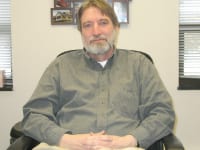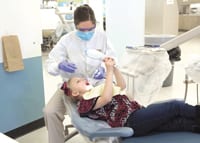Tools of the Trade Array Software Is Working to Make Hospital Management Easier
When asked what is is, exactly, that Array Software does, Greg Sikes has a simple answer. “We develop software applications for the health care space.”
But that description barely touches on the way a simple software tool can radically alter the way hospitals go about their day-to-day business — simply by streamlining it.
And with information technology becoming an increasingly essential component of health care with the emergence of electronic medical records, Agawam-based Array is set to build on its quarter-century of success in this ever-changing industry.
“Before launching Array, I had been a programmer and had worked at a company called Meditech in Cambridge,” Sikes said. “I learned their technology; they were an up-and-coming company in the health care space.”
From there, he worked at Digital Equipment as a software engineer before staking out ground as a consultant, doing programming work for hospitals. In that setting, he began to recognize a need for an electronic tool to manage surgical services.
As he explained, in order to minimize postponed, delayed, or cancelled cases, hospitals need to know that the necessary equipment, supplies, and staff will be available at the time of each surgery, and to accurately gauge the amount of time required for each surgeon to complete a case.
So he developed an electronic tool to manage those various aspects of surgery, and Array was born — 25 years ago this month, to be exact.
“I had a sudden realization that licensing software is a great idea; you do the work once and license it lots of times,” said Sikes, who quickly hired his childhood friend and neighbor, Ted Molloy, who’s still with the company today.
“And, really,” he continued, “if you’re in the hospital business, the operating room is one of the principal revenue centers. Hospitals needed an application to do a number of things — be able to schedule procedures and make sure things are scheduled at the right time, that they have all the resources they need. We were successful in that business and developed a lot of loyal customers.”
As he told HCN, the small (eight-employee) company has seen plenty of successes after that first one, and has become a model of IT entrepreneurship in the region, of constantly identifying needs in health care and developing, well, an array of tools to meet them.
On Task
After marketing the surgery-management product, dubbed OR+, Sikes recognized another need in hospitals: a tool to manage the service requests of different departments — a tool that has become Array’s main product.
“In the hospital, there are departments that get many, many requests,” he said, using information-technology departments as a prime example. “They’re constantly bombarded with ‘I need help with this report’ or ‘my printer’s not working’ or ‘we need to be installing this new application.’”
For many facilities, responsibility for managing service requests and tracking progress on projects falls to individual teams, and each team may employ any number of dfferent approaches, including incompatible tracking systems, e-mail, spreadsheets, and even paper notebooks. Clients who use Array’s TASK+ tool, on the other hand, ensure that all teams and departments are able to establish policies and procedures for project, change, and request management that become standard throughout the organization.
“The typical story was that requests were coming in different ways, from calls to e-mails to bumping into people in the hallway,” Sikes said. “All this stuff was happening, and the IT director would have, at any time, a hundred things going on. Managing it was kind of a nightmare. So we wrote a tool for one of our customers to help them manage that stuff, and it has become the core of our business.
“If your department gets a lot of service requests,” he continued, “you need to be able to track things like who asked for it, what do they want, how to get back to the people, and then what’s the status of it, is it in progress, what’s being done, who’s doing it — and then be able to share that information and pass it around.”
The tool has been a major success for Array, with clients as far-flung as Canada, Great Britain, and South Africa, in addition to hospitals in cities across the U.S. “We have consortiums of 49 facilities using our software, and then tiny, 25-bed hospitals that use it. We are always expanding into new markets. Yet, we’re still a small company and work really hard to provide excellent service. If you call Array, you won’t get an automated message; somebody always answers the phone.”
Streamlined Approach
Sikes said Array’s service-management tools can be adapted to other businesses, such as hotel management, that need to organize what can be large volumes of job orders and other requests. But health care remains a fertile field, as evidenced by the push toward electronic medical records (EMR).
The U.S. government is requiring all hospitals and other medical practices to comply with new EMR standards within the next few years, and federal funds are available to organizations that meet regulatory requirements. “Every hospital in the country is going through massive software updates,” he explained, but in many cases, the work of various departments to upgrade and test their software is fragmented and difficult to track.
However, Array has developed a tool called StreamTask+ that not only allows teams and departments to manage numerous requests, projects both modest and multi-phase, and recurring or periodic tasks, but also provides streamlined service records that help organizations meet regulatory and credentialing requirements.
“This is a great space to be in right now,” Sikes said, “because hospitals are focusing on this big effort to prove to the federal government that they’re meeting these meaningful-use requirements so they can get this carrot of federal funding — as opposed to the stick, which is a cut in federal funding if they don’t accomplish these goals.”
Helping move hospitals and other facilities toward that carrot is just one satisfying aspect of Sikes’ work over the past 25 years, but he says what he enjoys the most about running Array is simply the relationships he’s built up over that time.
“The people who work here in the company tend to stay for a long time. Most employees are lifers because it’s a nice place to work,” he told HCN. “And a lot of our customers, we’ve had for 20 years or more; I have a lot of lasting relationships with people who first bought the software 25 years ago, and I’m still meeting new people.”
And still thinking up new ways to turn an array of disparate tasks into something far more manageable.



Comments are closed.